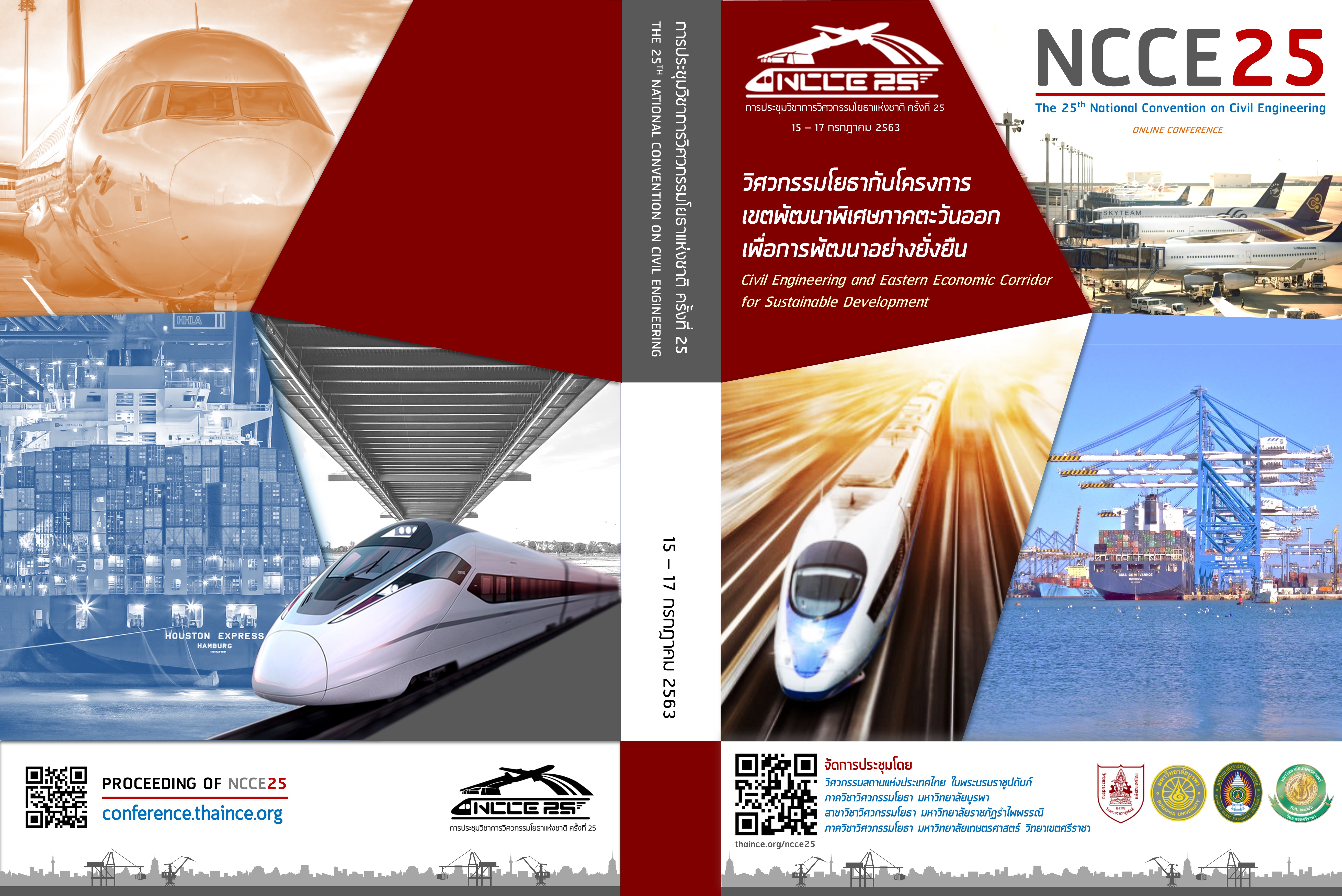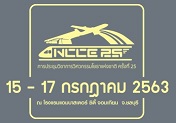Comparative Study using FGD-Gypsum and Calcium Sulfate on Mechanical Properties and Drying Shrinkage of Alkali-Activated High-Calcium Fly Ash Mortar
Keywords:
Alkali-activated high-calcium fly ash, FGD-gypsum, Calcium sulfate, Mechanical properties, Drying shrinkageAbstract
This research presents the comparative study using FGD gypsum (FGD) and calcium sulfate (CaSO4) on mechanical properties and drying shrinkage of alkali-activated high-calcium fly ash (FA) mortar. FA was replaced by FGD and Ca2SO4 at the rates of 5.0% and 2.5% by weight of binder, respectively. This ratio of FDG and Ca2SO4 was based on the previous study in term of low drying shrinkage of alkali-activated high-calcium FA paste. Sodium silicate (Na2SiO3) solution and 10M sodium hydroxide (NaOH) solution were used as liquid alkaline activation in all mixtures. Test results found that the use of FGD and Ca2SO4 to replace FA resulted in decreasing of setting time whereas its strength development improved. However, at the later stage, the compressive and flexural strengths of alkali-activated high-calcium FA with Ca2SO4 decreased. The use of FGD and Ca2SO4 in alkali-activated high-calcium FA mortar decreased its drying shrinkage, in which comparison with the control mix.
Downloads
References
[2] Allahverdi, A., Kani, E.N. and Yazdanipour, M., (2011). Effects of blast-furnace slag on natural pozzolan-based geopolymer cement. Ceramics-Silikaty, 55(1) : 68-78.
[3] Guo, X., Shi, H., Chen, L. and Dick, W., (2010). Alkali-activated complex binders from class C fly ash and Ca-containing admixtures. Journal of Hazardous Materials, 173(1-3), pp. 480-486.
[4] Garcia-Lodeiro, I, Palomo, A. Fernandez-Jimenez, A. and MacPhee DE, 2011. Compatibility studies between N-A-S-H and C-A-S-H gels. Study in the ternary diagram Na2O-CaO-Al2O3-SiO2-H2O. Cement and Concrete Research, 41(9), pp. 923-931.
[5] Ridtirud, C., Chindaprasirt, P., Pimraksa, K. (2011). Factors affecting the shrinkage of fly ash geopolymers. International Journal of Minerals, Metallurgy, and Materials. 18(1), pp. 100-104.
[6] Punurai, W., Kroehong, W., Saptamongkol, A., Chindaprasirt, P. (2018). Mechanical properties, microstructure and drying shrinkage of hybrid fly ash-basalt fiber geopolymer paste. Construction and Building Materials. 186, pp. 62-70.
[7] Fernández-Jiménez, A., Palomo, A., Criado, M. (2005). Microstructure development of alkali-activated fly ash cement: a descriptive model. Cement and Concrete Research. 35(6), pp. 1204-1209.
[8] Matalkah F, Salem T, Shaafaey M, Soroushian P. Drying shrinkage of alkali activated binders cured at room temperature. Construction and Building Materials. 2019;201:563-70.
[9] สกลวรรณ ห่านจิตสุวรรณ์, บวรรัก อินทร์จอหอ, ณัฐวัฒน์ เสาะสูงเนิน, ธนิศร เสาะสูงเนิน, ภัทรพล จัลวรรณ, อัครพล วะชุม, ฉัตรทริกา เพียงพิมาย และธนากร ภูเงินขำ (2563). ผลของสารผสมเพิ่มที่ขยายตัวต่อระยะเวลาก่อตัวและกำลังรับแรงอัดของวัสดุอัลคาไลจากเถ้าลอยแคลเซียมสูง. การประชุมวิชาการคอนกรีตประจำปี ครั้งที่ 15, 25-27 มีนาคม 2563, หน้า 216-220.
[10] ASTM C1437. (2015). Standard test method for flow of hydraulic cement mortar. Annual Book of ASTM Standard. Vol.04.01.
[11] ASTM C191. (2002). Standard test method for time of setting of hydraulic cement by Vicat needle. Annual Book of ASTM Standard. Vol.04.01.
[12] ASTM C109. (2002). Standard test method of compressive strength of hydraulic cement mortars. Annual Book of ASTM Standard. Vol.04.01.
[13] ASTM C78. (2018). Standard test method for flexural strength of concrete. Annual Book of ASTM Standard. Vol.04.01.
[14] ASTM C490. (2017). Standard practice for use of apparatus for the determination of length change of hardened cement paste, mortar, and concrete. Annual Book of ASTM Standard. Vol.04.01.
[15] ASTM C596. (2018). Standard test method for drying shrinkage of mortar containing hydraulic cement. Annual Book of ASTM Standard. Vol.04.01.
[16] กนกวรรณ ปันเขต และอุบลลักษณ์ รัตนศักดิ์, (2553). ผลของสารผสมเพิ่มต่อสมบัติของจีโอโพลิเมอร์จากเถ้าลอย. วารสารวิจัยและพัฒนา มจธ. ปีที่ 33ม ฉบับที่ 2, หน้า 121-132.
[17] Pangdaeng, S., Phoo-ngernkham, T., Sata, V., Chindaprasirt, P. (2014). Influence of curing conditions on properties of high calcium fly ash geopolymer containing Portland cement as additive. Materials & Design,. 53, pp. 269-274.
[18] Hanjitsuwan, S., Phoo-ngernkham, T., Damrongwiriyanupap, N. (2017). Comparative Study using Portland cement and Calcium Carbide Residue as a Promoter in Bottom Ash Geopolymer Mortar. Construction and Building Materials, 133, pp. 128-134.
[19] Phoo-ngernkham, T., Phiangphimai, C., Intarabut, D., Hanjitsuwan, S., Damrongwiriyanupap, N., Li, L.Y., (2020). Low cost and sustainable repair material made from alkali-activated high-calcium fly ash with calcium carbide residue. Construction and Building Materials. 247, pp. 118543.
[20] Phoo-ngernkham, T., Chindaprasirt, P., Sata, V., Pangdaeng, S., Sinsiri, T. (2013). Properteis of high calcium fly ash geopolymer pastes containing Portland cement as additive. International Journal of Minerals, metallurgy and Materials, 20(2), pp. 214-220.
[21] Phoo-ngernkham, T., Hanjitsuwan, S., Damrongwiriyanupap, N., Chindaprasirt, P. (2017). Effect of sodium hydroxide and sodium silicate solutions on strengths of alkali activated high calcium fly ash containing Portland cement. KSCE Journal of Civil Engineering, 21(6), pp. 2202-2010.
[22] Phoo-ngernkham, T., Maegawa, A., Mishima, N., Hatanaka, S., Chindaprasirt, P. (2015). Effects of sodium hydroxide and sodium silicate solutions on compressive and shear bond strengths of FA–GBFS geopolymer. Construction and Building Materials, 91, pp. 1-8.
[23] Phoo-ngernkham, T., Sata, V., Hanjitsuwan, S., Ridtirud, C., Hatanaka, S., Chindaprasirt, P. (2016). Compressive strength, bending and fracture characteristics of high calcium fly ash geopolymer mortar containing Portland cement cured at ambient temperature. Arabian Journal for Science and Engineering, 41(4), pp. 1263-71.
[24] Boonserm, K., Sata, V., Pimraksa, K., Chindaprasirt, P., (2012). Improved geopolymerization of bottom ash by incorporating fly ash using waste gypsum as additive. Cement & Concrete Composites, 34, pp. 819-824.
[25] Chindaprasirt, P., Thaiwitcharoen, S., Kawprion, S., Rattanasak, U. (2013). Controlling ettringite formation in FBC fly ash geopolymer concrete. Cement and Concrete Composites, 41, pp. 24-28.
Downloads
Published
How to Cite
Issue
Section
License
บทความทั้งหมดที่ได้รับการคัดเลือกให้นำเสนอผลงานในการประชุมวิชาการวิศวกรรมโยธาแห่งชาติ ครั้งที่ 25 นี้ เป็นลิขสิทธิ์ของ วิศวกรรมสถานแห่งประเทศไทย ในพระบรมราชูปถัมภ์



